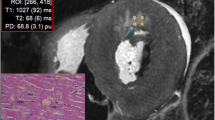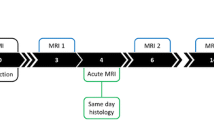Abstract
Objectives
Recently, an MRI quantification sequence has been developed which can be used to acquire T1- and T2-relaxation times as well as proton density (PD) values. Those three quantitative values can be used to describe soft tissue in an objective manner. The purpose of this study was to investigate the applicability of quantitative cardiac MRI for characterization and differentiation of ischaemic myocardial lesions of different age.
Materials and methods
Fifty post-mortem short axis cardiac 3 T MR examinations have been quantified using a quantification sequence. Myocardial lesions were identified according to histology and appearance in MRI images. Ischaemic lesions were assessed for mean T1-, T2- and proton density values. Quantitative values were plotted in a 3D-coordinate system to investigate the clustering of ischaemic myocardial lesions.
Results
A total of 16 myocardial lesions detected in MRI images were histologically characterized as acute lesions (n = 8) with perifocal oedema (n = 8), subacute lesions (n = 6) and chronic lesions (n = 2). In a 3D plot comprising the combined quantitative values of T1, T2 and PD, the clusters of all investigated lesions could be well differentiated from each other.
Conclusion
Post-mortem quantitative cardiac MRI is feasible for characterization and discrimination of different age stages of myocardial infarction.
Key Points
• MR quantification is feasible for characterization of different stages of myocardial infarction.
• The results provide the base for computer-aided MRI cardiac infarction diagnosis.
• Diagnostic criteria may also be applied for living patients.



Similar content being viewed by others
Abbreviations
- MRI:
-
magnetic resonance imaging
- pm MRI:
-
post mortem resonance imaging
- T:
-
Tesla
- T2w:
-
T2-weighted
- PD:
-
proton density
- TR:
-
repetition time
- TE:
-
echo time
- ROI:
-
region of interest
References
Patriquin L, Kassarjian A, Barish M et al (2001) Postmortem whole-body magnetic resonance imaging as an adjunct to autopsy: preliminary clinical experience. J Magn Reson Imaging 13:277–87
Roberts IS, Benbow EW, Bisset R et al (2003) Accuracy of magnetic resonance imaging in determining cause of sudden death in adults: comparison with conventional autopsy. Histopathology 42:424–30
Dirnhofer R, Jackowski C, Vock P, Potter K, Thali MJ (2006) VIRTOPSY: minimally invasive, imaging-guided virtual autopsy. Radiographics 26:1305–33
Lundström C, Persson A, Ross S et al (2012) State-of-the-art of visualization in post-mortem imaging. APMIS 120:316–26
Jackowski C, Thali MJ, Buck U et al (2006) Noninvasive estimation of organ weights by postmortem magnetic resonance imaging and multislice computed tomography. Invest Radiol 41:572–78
Jackowski C, Thali MJ, Aghayev E et al (2006) Postmortem imaging of blood and its characteristics using MSCT and MRI. Int J Legal Med 120(4):233–40
Fitzmaurice GJ, Wishart V, Graham AN (2013) An unexpected mortality following cardiac surgery: a post-mortem diagnosis of cardiac amyloidosis. Gen Thorac Cardiovasc Surg 61:417–21
Aghayev E, Sonnenschein M, Jackowski C et al (2006) Postmortem radiology of fatal hemorrhage: measurements of cross-sectional areas of major blood vessels and volumes of aorta and spleen on MDCT and volumes of heart chambers on MRI. AJR Am J Roentgenol 187:209–15
Kuroiwa Y, Yamashita A, Nishihira K et al (2011) Cardiac rupture in acute myocardial infarction: post-mortem MR imaging. Magn Reson Med Sci 10:255–58
Jackowski C, Christe A, Sonnenschein M, Aghayev E, Thali MJ (2006) Postmortem unenhanced magnetic resonance imaging of myocardial infarction in correlation to histological infarction age characterization. Eur Heart J 27:2459–67
Jackowski C, Warntjes MJ, Berge J, Bar W, Persson A (2011) Magnetic resonance imaging goes postmortem: noninvasive detection and assessment of myocardial infarction by postmortem MRI. Eur Radiol 21:70–8
Thayyil S, Sebire NJ, Chitty LS et al (2013) Post-mortem MRI versus conventional autopsy in fetuses and children: a prospective validation study. Lancet 382:223–33
Jackowski C, Hofmann K, Schwendener N, Schweitzer W, Keller-Sutter M (2011) Coronary thrombus and peracute myocardial infarction visualized by unenhanced postmortem MRI prior to autopsy. Forensic Sci Int 214:e16–e9
Jackowski C, Schweitzer W, Thali MJ et al (2005) Virtopsy: postmortem imaging of the human heart in situ using MSCT and MRI. Forensic Sci Int 149:11–23
Jackowski C, Schwendener N, Grabherr S, Persson A (2013) Postmortem cardiac 3 T magnetic resonance imaging: Visualizing the sudden cardiac death? J Am Coll Cardiol 62:617–29
Jachau K, Heinrichs T, Kuchheuser W et al (2004) Computed tomography and magnetic resonance imaging compared to pathoanatomic findings in isolated human autopsy hearts. Rechtsmedizin 14:109–16
Warntjes JB, Dahlqvist O, Lundberg P (2007) Novel method for rapid, simultaneous T1, T*2, and proton density quantification. Magn Reson Med 57:528–37
Warntjes JB, Leinhard OD, West J, Lundberg P (2008) Rapid magnetic resonance quantification on the brain: Optimization for clinical usage. Magn Reson Med 60:320–29
Warntjes MJ, Kihlberg J, Engvall J (2010) Rapid T1 quantification based on 3D phase sensitive inversion recovery. BMC Med Imaging. doi:10.1186/1471-2342-10-19
Blystad I, Warntjes JB, Smedby O et al (2012) Synthetic MRI of the brain in a clinical setting. Acta Radiol 53:1158–63
Jackowski C, Warntjes MJ, Kihlberg J, Berge J, Thali MJ, Persson A (2011) Quantitative MRI in isotropic spatial resolution for forensic soft tissue documentation. Why and how? J Forensic Sci 56:208–15
SyntheticMR products website. Available at: http://www.syntheticmr.com. Accessed May 31, 2014.
Ljung P, Winskog C, Persson A, Lundström C, Ynnerman A (2006) Full body virtual autopsies using a state-of-the-art volume rendering pipeline. IEEE Trans Vis Comput Graph 12:869–76
Persson A, Lindblom M, Jackowski C (2011) A state-of-the-art pipeline for postmortem CT and MRI visualization: from data acquisition to interactive image interpretation at autopsy. Acta Radiol 52:522–36
H-Ici DO, Jeuthe S, Al-Wakeel N et al (2014) T1 mapping in ischemic heart disease. Eur Heart J Cardiovasc Imaging 15(6):597–602
Sharma V, Binukrishnan S, Schoepf UJ, Ruzsics B (2014) Myocardial Tissue Characterization With Magnetic Resonance Imaging. J Thorac Imaging Jan 4. [Epub ahead of print]
Ding H, Fernandez-de-Manuel L, Schär M et al (2014) Three-dimensional whole-heart T2 mapping at 3T. Magn Reson Med. doi:10.1002/mrm.25458
Karmonik C, Malaty A, Bikram M, Schmitt P, Partovi S, Shah DJ (2014) Fast in vivo quantification of T1 and T2 MRI relaxation times in the myocardium based on inversion recovery SSFP with in vitro validation post Gd-based contrast administration. Cardiovasc Diagn Ther 4(2):88–96
Van Heeswijk RB, Feliciano H, Bongard C et al (2012) Free-breathing 3 T magnetic resonance T2-mapping of the heart. JACC Cardiovasc Imaging 5(12):1231–9
Blume U, Lockie T, Stehning C et al (2009) Interleaved T(1) and T(2) relaxation time mapping for cardiac applications. J Magn Reson Imaging 29(2):480–7
Jansen CH, Perera D, Makowski MR et al (2011) Detection of intracoronary thrombus by magnetic resonance imaging in patients with acute myocardial infarction. Circulation 124:416–24
Haacke ME, Brown RW, Thompson MR, Venkatesh N (1999) Magnetic resonance imaging-physical principles and sequence design, 1st edn. John Wiley & Sons, New York
Zech W, Schwendener N, Kneubuehl B, Persson A, Warntjes MJ, Jackowski C. (2014) Temperature dependence of post-mortem MR quantification for soft tissue discrimination and sequence optimization. Submitted for publication in European Radiology; April 2014
Acknowledgements
The scientific guarantor of this publication is Prof. Christian Jackowski MD, Head of Departement Institute of Forensic Medicine Bern, Switzerland. The authors of this manuscript declare no relationships with any companies, whose products or services may be related to the subject matter of the article. The authors state that this work has not received any funding. Beat Kneubuehl, PhD, kindly provided statistical advice for this manuscript. Institutional Review Board approval was not required because all cases/corpses were investigated by order of the local prosecutors. The prosecutors agreed to research on corpses when the personal data of the deceased persons are treated strictly confidential. Since we treat all personal data of corpses as confidential we have information from the Institutional Review Board that approval from the Review Board is not necessary for all our conducted post-mortem studies including post-mortem imaging. Written informed consent was not required for this study because the subjects studied were deceased persons. None of the study subjects or cohorts have been previously reported. Methodology: prospective, experimental, performed at one institution.
Author information
Authors and Affiliations
Corresponding author
Rights and permissions
About this article
Cite this article
Zech, WD., Schwendener, N., Persson, A. et al. Postmortem MR quantification of the heart for characterization and differentiation of ischaemic myocardial lesions. Eur Radiol 25, 2067–2073 (2015). https://doi.org/10.1007/s00330-014-3582-2
Received:
Revised:
Accepted:
Published:
Issue Date:
DOI: https://doi.org/10.1007/s00330-014-3582-2




